
Bluff Hall is a historic residence in Demopolis, Alabama, United States. The original portion of the house is in the Federal style with later additions that altered it to the Greek Revival style. It was documented as part of the Historic American Buildings Survey in 1936, and added to the National Register of Historic Places in 1970. It serves as a historic house museum, with the interior restored to an 1850s appearance.

Cannondale Historic District is a historic district in the Cannondale section in the north-central area of the town of Wilton, Connecticut. The district includes 58 contributing buildings, one other contributing structure, one contributing site, and 3 contributing objects, over a 202 acres (82 ha). About half of the buildings are along Danbury Road and most of the rest are close to the Cannondale train station .The district is significant because it embodies the distinctive architectural and cultural-landscape characteristics of a small commercial center as well as an agricultural community from the early national period through the early 20th century....The historic uses of the properties in the district include virtually the full array of human activity in this region—farming, residential, religious, educational, community groups, small-scale manufacturing, transportation, and even government. The close physical relationship among all these uses, as well as the informal character of the commercial enterprises before the rise of more aggressive techniques to attract consumers, capture some of the texture of life as lived by prior generations. The district is also significant for its collection of architecture and for its historic significance.

The Abraham Brower House is located at Water and Division streets in New Hamburg, New York, United States. It is a mid-19th century home of one of the hamlet's early residents that was added to the National Register of Historic Places in 1987. It is opposite the Adolph Brower House, also on Water Street.

The James Williams House is a historic home and farm complex located at Kenton, Kent County, Delaware. The house was built in 1848, and is a two-story, five bay, center hall plan brick dwelling with Greek Revival details. It has a rear wing. The front facade features a three-bay porch with chamfered posts and sawn decorative brackets dated to the 1880s. Also on the property are a contributing barn, granary, and outhouse.

White-Pound House is a historic home in Lockport in Niagara County, New York. The 2+1⁄2-story, 3,000+ square-foot stone structure was built in 1835 and remodeled in the Italianate style in the late nineteenth century. Today, the house retains its late nineteenth-century appearance on both its exterior and interior and is distinguished by its sophisticated detailing. The fine stone masonry workmanship, elaborate decorative detail and the high level of architectural integrity make the White-Pound house a prominent local landmark and an important example of Lockport's legacy of stone architecture. It is one of approximately 75 stone residences remaining in the city of Lockport.
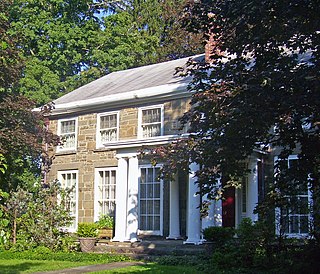
The house at 322 Albany Avenue, in Kingston, New York, United States, is a stone building dating to the early 19th century. In the 1840s it was renovated in the Greek Revival architectural style.

The Raphael Semmes House, also known as the Horta–Semmes House, is a historic residence in Mobile, Alabama. It is best known for having been the home of Admiral Raphael Semmes, captain of the Confederate sloop-of-war CSS Alabama. The house was added to the National Register of Historic Places on February 26, 1970.

The Acors Barns House is located in New London, Connecticut. Built in 1837, the Acors Barns House is a two-and-one half story Greek Revival house with a gable roof and clapboarded exterior. The front facade of the house is five bays wide with a Greek Revival portico leading to the main entrance. Additions to the house include a projecting center dormer, and second-story projection over a partially enclosed veranda. The plain exterior is contrasted by interior's elaborate hall ceilings, detailed woodwork and arched marble fireplaces.
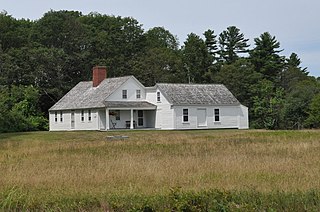
The Tarr–Eaton House, also known as Tarr–Eaton–Hackett House, is an historic house at 906 Harpswell Neck Road in Harpswell, Maine. Built before 1783 and enlarged about 1840, it is a well-preserved 18th-century Cape with added Greek Revival features, and one of Harpswell's few surviving pre-Revolutionary War buildings. It was listed on the National Register of Historic Places in 2001.

The Emma J. Harvat and Mary E. Stach House, also known as the De Saint Victor House, was the home of Emma J. Harvat, who was the first female mayor of Iowa City, Iowa and the first female leader of a U.S. city with a population greater than 10,000. Harvat was a successful businesswoman who had become financially independent and retired to Iowa City at the age of 43. After arriving there she became partner in another business venture with Mary (May) Stach, establishing Harvat and Stach to sell women's clothing. Harvat and Stach had the house on Davenport Street built for them in 1919. The house was designed by Iowa City architect Orville H. Carpenter, incorporating a variety of historical revival styles, dominated by Colonial Revival.
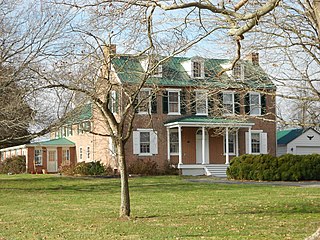
Linden Hill is a historic home located at St. Georges, New Castle County, Delaware. It was built in 1836, and is a 2+1⁄2-story, five bay brick dwelling with a center hall plan. It has long kitchen wing set at a right angle to the main house. The front facade features a three bay porch with a hipped roof. The interior features Greek Revival style details. Also on the property are a contributing frame barn and shed.

Gordon Hall, also known as the Judge Samuel W. Dexter House, is a private house located at 8341 Island Lake Road in Dexter, Michigan. It was designated a Michigan State Historic Site in 1958 and listed on the National Register of Historic Places in 1972. The house is unique in Michigan for its balance, large scale, and massive hexastyle portico. The structure is also significant as the dwelling of Judge Samuel W. Dexter, a pioneering Michigan resident and land baron who had a substantial impact on early development of Washtenaw County and other sections of the state. The house was later owned by Dexter's granddaughter Katharine Dexter McCormick, a pioneering research scientist, suffragist, and philanthropist. In its early days, Gordon Hall hosted at least two, and possibly three United States presidents, and it was almost certainly a stop along the Underground Railroad.

The White–Turner–Sanford House is a historic residence in Huntsville, Alabama. It was built in 1827 by James White, a merchant from Virginia, on land purchased from LeRoy Pope. The home has had numerous owners through the years including John H. Lewis, mayor from 1826 to 1828, and state representative George W. Lane. Originally a one-story Federal-style house, a two-story Greek Revival addition was built in 1858. The original part of the house consists of a center-hall main block with an ell. It is built of brick laid in common bond, with a gable roof. A portico supported by four thin columns covers the main entrance, which sports a four-panel transom. Windows on the main block are the original rectangular sashes, except the windows on the façade which were modified with segmental arched tops to match the addition. The original portion contains a hall flanked by a parlor and reception room, with two bedrooms behind the parlor. A porch, kitchen, and bath filling in the ell were added after the Civil War. The addition has a study and dining room on the ground floor and two bedrooms above. The house was listed on the National Register of Historic Places in 1984. It has been converted into a financial planning office.
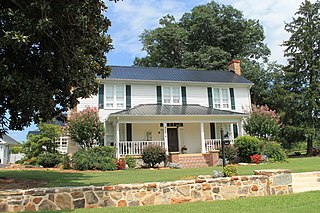
The Bush House is a historic house located at 3960 New Cut Road near Inman, Spartanburg County, South Carolina.
Marshall Kornegay House and Cemetery is a historic plantation house located near Suttontown, Sampson County, North Carolina. The house was built about 1835, and is a 2+1⁄2-story, four bay by three bay, transitional Federal / Greek Revival style frame dwelling. It has a gable roof, rear ell, and one-story hip roofed front porch. The interior follows a hall-and-parlor plan. The house was restored in 1980–1981. Also on the property is a contributing family cemetery.

The Sadler House is a frontier I-House with Georgian architectural elements in McCalla, Alabama. The original single pen log house was built by John Loveless, who moved to Alabama from South Carolina in 1816. The home's uniqueness is illustrated by and due to its original constructed form of a single pen log structure, now cocooned within the I-house, and the complex joinery details used to hold the structural elements of the original house in place.
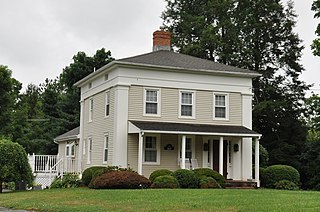
The Capt. Samuel Woodruff House is a historic house at 23 Old State Road in Southington, Connecticut. Built about 1840, it is a well-preserved and somewhat rare example of a square Greek Revival farmhouse. It was listed on the National Register of Historic Places in 1989.

The Thomas H. Palmer House is a historic house at 2636 United States Route 7 in Pittsford, Vermont. Built in 1832, it is a relatively upscale brick house, with Federal and Greek Revival styling. It is notable as the home of Thomas Palmer, an influential figure in the development of Pittsford and state-level educational standards in the mid-19th century. The house was listed on the National Register of Historic Places in 1978.

The Fowler-Steele House, also known historically as Ivy Hall, is a historic house on North Main Street in Windsor, Vermont, United States. Built in 1805 and restyled about 1850, it has an architecturally distinctive blend of Federal and Greek Revival styles. It served for many years as a local church parsonage. It was listed on the National Register of Historic Places in 1982.

The Williams House is a historic single-family residence located at 5 Williams Road in New Fairfield, Connecticut. Likely built between 1800 and 1835, it is a well-preserved example of early American residential architecture, with transitional Federal and Greek Revival features. The house was listed on the National Register of Historic Places in 2014.





















